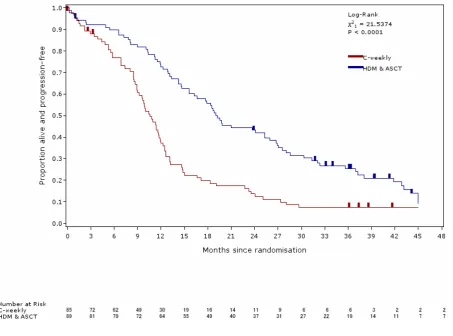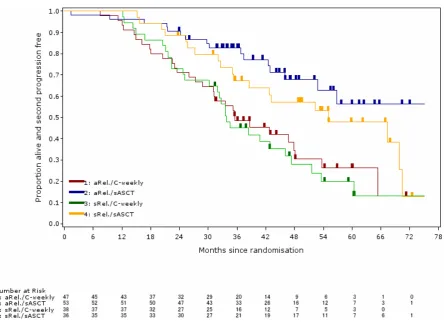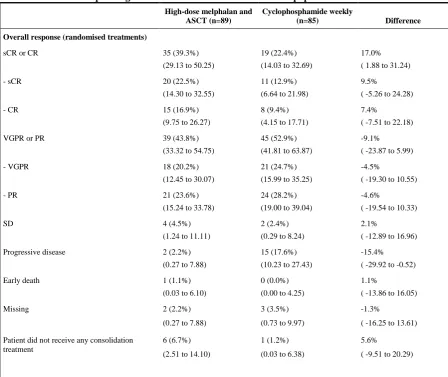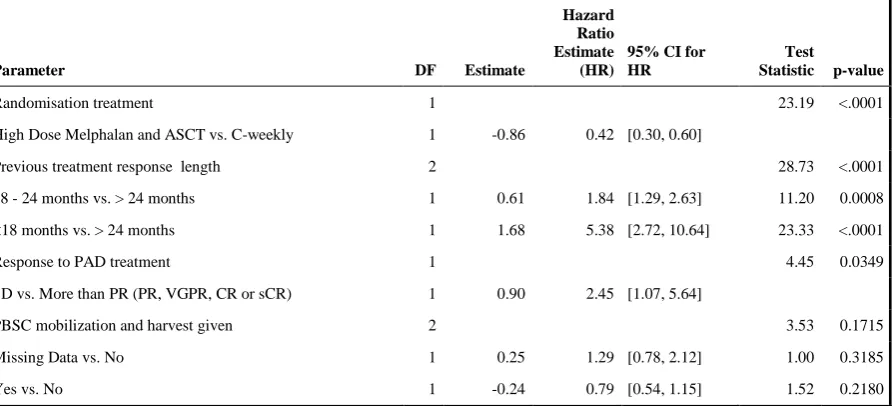This is a repository copy of
The effect of salvage autologous stem-cell transplantation on
overall survival in patients with relapsed multiple myeloma (final results from
BSBMT/UKMF Myeloma X Relapse [Intensive]): a randomised, open-label, phase 3 trial.
.
White Rose Research Online URL for this paper:
http://eprints.whiterose.ac.uk/102966/
Version: Accepted Version
Article:
Cook, G, Ashcroft, AJ, Cairns, DA orcid.org/0000-0002-2338-0179 et al. (16 more authors)
(2016) The effect of salvage autologous stem-cell transplantation on overall survival in
patients with relapsed multiple myeloma (final results from BSBMT/UKMF Myeloma X
Relapse [Intensive]): a randomised, open-label, phase 3 trial. The Lancet Haematology, 3
(7). e340-e351.
https://doi.org/10.1016/S2352-3026(16)30049-7
© 2016, Elsevier. Licensed under the Creative Commons
Attribution-NonCommercial-NoDerivatives 4.0 International
http://creativecommons.org/licenses/by-nc-nd/4.0/
eprints@whiterose.ac.uk https://eprints.whiterose.ac.uk/ Reuse
Unless indicated otherwise, fulltext items are protected by copyright with all rights reserved. The copyright exception in section 29 of the Copyright, Designs and Patents Act 1988 allows the making of a single copy solely for the purpose of non-commercial research or private study within the limits of fair dealing. The publisher or other rights-holder may allow further reproduction and re-use of this version - refer to the White Rose Research Online record for this item. Where records identify the publisher as the copyright holder, users can verify any specific terms of use on the publisher’s website.
Takedown
If you consider content in White Rose Research Online to be in breach of UK law, please notify us by
1 Table of Contents
1 Collaborators
In addition to the authors, the following investigators participated in the study:
Recruiting centre Principal Investigator Number of participants registered
Nottingham University Hospital Dr Cathy Williams 30
University College London Hospital Dr Kwee Yong 17
Royal Hallamshire Hospital Dr John Snowden 14
Leeds Teaching Hospitals Prof Gordon Cook 14
Derriford Hospital Dr Hannah Hunter 11
Christie Hospital Dr Jim Cavet 10
St. Bartholomew's Hospital Dr Heather Oakervee 10
Bristol Haematology & Oncology Centre Dr Jenny Bird 9
Birmingham Heartlands Hospital Dr Guy Pratt 8
Gloucestershire Royal Hospital Dr Sally Chown 8
Glan Clwyd Dr Earnest Heartin 7
Manchester Royal Infirmary Dr Eleni Tholouli 7
Addenbrookes Hospital Dr Jenny Craig 7
Ipswich Hospital Dr A J Ademokun 7
Royal Derby Hospital Dr David Allotey 7
Castle Hill Hospital Dr Haz Sayala 7
Medway Maritime Hospital Dr Vivienne Andrews 6
Southampton University Hospital Dr Matthew Jenner 6
Guy’s & St Thomas’ NHS Foundation Trust Dr Majid Kazmi 5
Frenchay Hospital Dr Alastair Whiteway 5
Singleton Hospital Dr Hamdi Sati 5
Kings College Hospital Prof Steve Schey 5
Leicester Royal Infirmary Dr Claire Chapman 5
James Cook Hospital Dr Angela Wood 4
St Helier & Epsom Hospitals Dr Simon Stern 4
Queen Elizabeth Hospital, Birmingham Dr Mark Cook 4
Aberdeen Royal Infirmary Dr Jane Tighe 4
Colchester Hospital Dr Gavin Campbell 4
Rotherham General Hospital Dr Helen Barker 4
Beatson West of Scotland Cancer Centre Dr Grant McQuaker 4
Belfast City Hospital Dr Mary Drake 4
Ysbyty Gwynedd Dr Melinda Hamilton 3
Stafford Hospital Dr Paul Revell 3
Royal Berkshire NHS Foundation Trust Dr Henri Grech 3
Chesterfield Royal Hospital Dr Emma Welch 3
Doncaster Royal Infirmary Dr Youssef Sorour 3
St Georges Hospital Dr Fenella Willis 3
Ninewells Hospital Dr Duncan Gowans 2
Bradford Royal Infirmary Dr Samuel Ackroyd 2
Crosshouse and Ayr Hospitals Dr Julie Gillies 2
Norfolk & Norwich Hospital Dr Martin Auger 2
Diana Princess of Wales Hospital Dr Susan Levison Keating 2
Raigmore Hospital Dr Peter Forsyth 2
Royal Devon & Exeter Hospital Dr Malcolm Hamilton 2 Sandwell & West Birmingham Hospitals Dr Farooq Wandroo 2
University Hospital Coventry Dr Syed Bokhari 2
University Hospital of Wales, Cardiff Dr Keith Wilson 2
Dorset County Hospital Dr Akeel Moosa 2
Queens Hospital, Burton Dr Hamayun Ahmed 2
Torbay Hospital Dr Deborah Turner 2
Cheltenham General Hospital Dr Sally Chown 1
The Great Western Hospital, Swindon Dr Norbert Blesing 1 United Lincolnshire Hospitals Dr Kandeepan Saravanamuttu 1
3
Salisbury Hospital Dr Jonathan Cullis 1
Mid Yorkshire Hospitals NHS Trust Dr John Ashcroft 1
Russells Hall Hospital Dr Savio Fernandes 1
Countess of Chester Hospital Dr Salaheddin Tueger 1
Royal Oldham Hospital Dr Vivek Sen 1
Warwick Hospital Dr Anton Borg 1
2 Appendix Figures
Figure 1: Trial CONSORT flow diagram.
297 eligible patients were registered
293 patients received re-induction treatment
1 patient received no trial treatment 3 patients withdrew and received no trial treatment
7 patients withdrew during re-induction treatment
1 patient had no central laboratory response assessment
2 patients had progressive disease 2 patients died (without progressive disease) prior to response assessment
2 patients completed only 1 cycle of re-induction therapy
279 patients had ≥SD
response to re-induction
174 eligible and willing patients were randomised
89 patients were randomised to high-dose melphalan and ASCT
3 patients withdrew prior to randomisation screening
1 patient withdrew prior to randomisation screening and was subsequently found to have progressed on the same day
12 patients withdrawn by clinician 3 patients died (2 with progressive disease) prior to randomisation screening
166 patients did not have PBSC mobilisation and harvest
70 patients had adequate stem cells after mobilisation
123 patients had adequate stem cells stored
3 patients withdrew prior to mobilisation
110 patients had PBSC mobilisation and harvest
(26 patients had sufficient stem cells stored from previous harvest)
85 patients were randomised to cyclophosphamide weekly
3 patients withdrew and did not undergo PBSC mobilisation
17 patients died without undergoing PBSC mobilisation (13 with progressive disease) 1 patient had progressive disease 22 patients did not undergo PBSC mobilisation due to clinician decision
2 patients withdrew during PBSC mobilisation
7 patients died during PBSC mobilisation (6 with progressive disease)
1 patient had progressive disease
30 patients did not mobilise sufficient stem cells
TTP: 71 patients have progressive disease 18 patients are progression-free
OS: 31 patients have died
58 patients are alive
1 patient received no consolidation treatment 6 patients received no consolidation treatment
TTP: 75 patients have progressive disease 10 patients are progression-free
OS: 44 patients have died
5 Figure 2: TTP (updated analysis of the trial primary endpoint)
P ro p o rt io n p ro g re s s io n -fr e e 0.0 0.1 0.2 0.3 0.4 0.5 0.6 0.7 0.8 0.9 1.0
Months since randomisation
0 3 6 9 12 15 18 21 24 27 30 33 36 39 42 45 48
Log-R a nk 2
1 = 22.9135 P < 0.0001
Num be r a t R isk C -we e k ly sASC T
85 72 62 49 30 19 16 14 11 9 6 6 6 3 2 2 2
89 81 79 72 64 55 49 40 37 31 27 22 19 14 11 7 7
11 3 Appendix Tables
Table 1: response to PAD with corresponding 95% confidence intervals for patients in the all registered patients ITT population
Total (n=297)
Overall response (PAD)
sCR or CR 49 (16.5%) (12.46 to 21.22)
- sCR 23 (7.7%) (4.97 to 11.39)
- CR 26 (8.8%) (5.80 to 12.56)
VGPR or PR 186 (62.6%) (56.85 to 68.15)
- VGPR 62 (20.9%) (16.40 to 25.95)
- PR 124 (41.8%) (36.08 to 47.59)
SD 44 (14.8%) (10.98 to 19.37)
Progressive disease 2 (0.7%) (0.08 to 2.41)
Early death 2 (0.7%) (0.08 to 2.41)
Missing 10 (3.4%) (1.63 to 6.10)
Patient did not receive any PAD treatment 4 (1.3%) (0.37 to 3.41)
Table 2: overall response rate following randomised treatments: response following randomised treatments with corresponding 95% confidence intervals for the ITT population
High-dose melphalan and ASCT (n=89)
Cyclophosphamide weekly
(n=85) Difference
Overall response (randomised treatments)
sCR or CR 35 (39.3%)
(29.13 to 50.25)
19 (22.4%) (14.03 to 32.69)
17.0% ( 1.88 to 31.24)
- sCR 20 (22.5%)
(14.30 to 32.55)
11 (12.9%) (6.64 to 21.98)
9.5% ( -5.26 to 24.28)
- CR 15 (16.9%)
(9.75 to 26.27)
8 (9.4%) (4.15 to 17.71)
7.4% ( -7.51 to 22.18)
VGPR or PR 39 (43.8%)
(33.32 to 54.75)
45 (52.9%) (41.81 to 63.87)
-9.1% ( -23.87 to 5.99)
- VGPR 18 (20.2%)
(12.45 to 30.07)
21 (24.7%) (15.99 to 35.25)
-4.5%
( -19.30 to 10.55)
- PR 21 (23.6%)
(15.24 to 33.78)
24 (28.2%) (19.00 to 39.04)
-4.6%
( -19.54 to 10.33)
SD 4 (4.5%)
(1.24 to 11.11)
2 (2.4%) (0.29 to 8.24)
2.1%
( -12.89 to 16.96)
Progressive disease 2 (2.2%)
(0.27 to 7.88)
15 (17.6%) (10.23 to 27.43)
-15.4% ( -29.92 to -0.52)
Early death 1 (1.1%)
(0.03 to 6.10)
0 (0.0%) (0.00 to 4.25)
1.1%
( -13.86 to 16.05)
Missing 2 (2.2%)
(0.27 to 7.88)
3 (3.5%) (0.73 to 9.97)
-1.3%
( -16.25 to 13.61)
Patient did not receive any consolidation treatment
6 (6.7%) (2.51 to 14.10)
1 (1.2%) (0.03 to 6.38)
5.6% ( -9.51 to 20.29)
13
Table 3: Fine-Gray Competing risks regression analysis for randomised treatment accounting for the stratification factors and whether or not PBSC mobilization and harvest was given.
Parameter DF Estimate
Hazard Ratio Estimate (HR)
95% CI for HR
Test
Statistic p-value
Randomisation treatment 1 23.19 <.0001
High Dose Melphalan and ASCT vs. C-weekly 1 -0.86 0.42 [0.30, 0.60]
Previous treatment response length 2 28.73 <.0001
18 - 24 months vs. > 24 months 1 0.61 1.84 [1.29, 2.63] 11.20 0.0008
<18 months vs. > 24 months 1 1.68 5.38 [2.72, 10.64] 23.33 <.0001
Response to PAD treatment 1 4.45 0.0349
SD vs. More than PR (PR, VGPR, CR or sCR) 1 0.90 2.45 [1.07, 5.64]
PBSC mobilization and harvest given 2 3.53 0.1715
Missing Data vs. No 1 0.25 1.29 [0.78, 2.12] 1.00 0.3185









